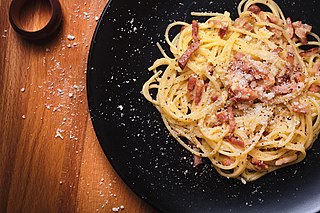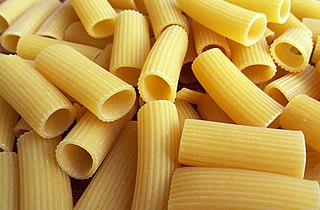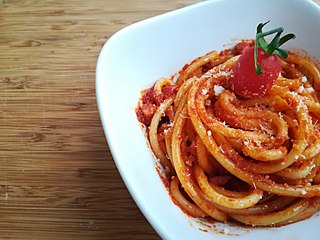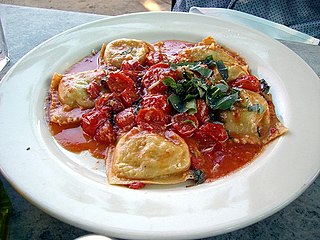
Carbonara is a pasta dish made with fatty cured pork, hard cheese, eggs, salt, and black pepper. It is typical of the Lazio region of Italy. The dish took its modern form and name in the middle of the 20th century.

Tortellini is a type of stuffed pasta typical of the Italian cities of Bologna and Modena, in the Emilia-Romagna region. Traditionally it is stuffed with a mix of meat, Parmesan cheese, egg and nutmeg and served in capon broth.

Fettuccine is a type of pasta popular in Roman cuisine. It is descended from the extremely thin capelli d'angelo of the Renaissance, but is a flat, thick pasta traditionally made of egg and flour. At about 6.5 mm, it is wider and thicker than, but similar to, the tagliatelle typical of Bologna, which are more common elsewhere in Italy and is often used as a synonym. Spinach fettuccine is made from spinach, flour and eggs.

Agnolotti is a type of stuffed pasta typical of the Piedmont region of Italy, made with small pieces of flattened dough folded over a filling of roasted meat or vegetables. Agnolotti can be di magro or di grasso depending on their filling of vegetables or meat.

Spaghetti alla puttanesca is a pasta dish invented in Naples in the mid-20th century and made typically with tomatoes, olives, capers, anchovies, garlic, peperoncino, extra virgin olive oil and salt.

Cavatelli are small pasta shells made from semolina or other flour dough, commonly cooked with garlic and broccoli or rapini broccoli rabe, or simply with tomato sauce. A variant adds ricotta cheese to the dough mix. Another variant with seafood is very popular in seaside cities and villages.

Rigatoni are a type of pasta. They are larger than penne and ziti, and sometimes slightly curved, but not as curved as elbow macaroni. Rigatoni are characterized by ridges along their length, sometimes spiraling around the tube; unlike penne, the ends of rigatoni are cut perpendicular to the tube walls instead of diagonally.

Amatriciana sauce, known in Italian as sugo all'amatriciana or as salsa all'amatriciana, is a pasta sauce made with tomatoes, guanciale, pecorino romano cheese, black pepper, extra virgin olive oil, dry white wine, and salt. Originating in the comune (municipality) of Amatrice, the amatriciana is one of the best known pasta sauces in present-day Roman and Italian cuisine. The Italian government has named it a prodotto agroalimentare tradizionale (PAT) of Lazio, and amatriciana tradizionale is registered as a traditional speciality guaranteed (TSG) in the EU and the UK.

Guanciale is an Italian salt-cured meat product prepared from pork jowl or cheeks. Its name is derived from guancia, meaning 'cheek'. Its rendered fat gives flavour to and thickens the sauce of pasta dishes.

Orecchiette are a pasta typical of the Apulia region of Italy. Their name comes from their shape, which resembles a small ear.

Marinara sauce is a tomato sauce usually made with tomatoes, garlic, herbs, and onions. Variations include capers, olives, spices, and a dash of wine. Widely used in Italian-American cuisine, it is known as alla marinara in its native Italy, where it is typically made with tomatoes, basil, olive oil, garlic, and oregano, but also sometimes with olives, capers, and salted anchovies. It is used for spaghetti and vermicelli, but also with meat or fish.

Spaghetti aglio e olio is a pasta dish typical of the Italian city of Naples, in the Campania region. Its popularity can be attributed to it being simple to prepare and the fact that it makes use of inexpensive, readily available ingredients that have long shelf lives in a pantry.

Bolognese sauce, known in Italian as ragù alla bolognese or ragù bolognese, is a meat-based sauce in Italian cuisine, typical of the city of Bologna. It is customarily used to dress tagliatelle al ragù and to prepare lasagne alla bolognese.

Maltagliati, also known as puntarine, are a type of pasta typical of the Emilia-Romagna region of Italy. In the manufacture of pasta such as tagliatelle, dough is rolled and then cut into thin strips, producing noodles. The excess parts of the dough, generally the edges, are left with irregular shape and thickness, therefore "poorly cut" or, in Italian, maltagliati. Maltagliati are therefore cut from such scrap pieces of pasta, and differ in shape, size and thickness.

Paccheri is a type of pasta in the shape of a very large tube, originating from the Campania region of Italy. They are generally smooth, but there is also a ribbed version, paccheri millerighe. The name comes from Neapolitan paccharia, 'slaps', with a depreciative -ero to indicate something common. The name has been ascribed to a slapping sound they may make when eaten. They can be served stuffed.

Bigoli in salsa is a Venetian pasta dish made with whole-wheat bigoli pasta, onion and salt-cured fish. While today usually anchovy is used, in earlier days it was often prepared with sardines. It is considered one of the signature dishes of Venice.

Ciceri e tria is a pasta dish originating in the Salento region. It is prepared with pasta and chickpeas as primary ingredients, and includes fried pasta. It has been described as a "classic and emblematic dish of Salentine cuisine" and as a specialty dish of Apulia.

Spaghetti alla chitarra, also known as maccheroni alla chitarra, is a variety of egg pasta typical of the Abruzzo region of Italy, with a square cross section about 2–3 mm thick. Tonnarelli are a similar pasta from Lazio, used especially in the Roman cacio e pepe. Ciriole, traditionally from Molise, is the thicker version of chitarra, approximately twice the thickness of spaghetti. Because the pasta are cut from a sheet rather than extruded through a die, spaghetti alla chitarra are square rather than round in cross-section.

Pasta alla gricia is a pasta dish originating in the Lazio region of Italy.






























































































































































